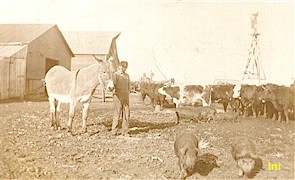|
We also have jack and mule results from the 1904 World's Fair |
|
The domestication of the jack stocks’ ancestors began with the herds of wild asses found in the African and Asiatic regions. Around 3,700 B.C., the Egyptians are the first known group to make reference to the domestication of these animals. In the early sixth century B.C., there is information found concerning the presence of the use of mules. Columbus and other Spanish explorers brought domesticated asses with them. The small American burro is a descendant of those brought over from Spain.
A Missouri farmer with his jack. Being a hardy animal able to withstand arid climates and live on low quality food sources, the ass was the most economical choice for many. Of these animals the jack stock was of great importance to those in America for the production of mules. Without them, agriculture would not have been the great economic foundation of the United States. They helped pull newly invented farm equipment, such as the mowing, reaping and threshing machines, steel plows, corn planter, and the two horse cultivator. The south would not have been to thrive with the cotton fields if it had not been for the use of mules. The first mention of mules in Missouri can be found in newspaper articles printed during the early Santa Fe trading expedition. It is said that the Missouri mules developed into the heaviest and largest draft type animals when compared to those around the world. Europeans imported a jack, called Mammoth, to Kentucky from 1840-1850, who was instrumental in the production of a larger type of jack stock. Kentucky jennets sired by Mammoth were then bred to a Maryland jack, called Warrior, producing superior jack stock offspring. The large jack stock had to be bred to heavy draft type mares to produce a large mule hardy enough to withstand rough treatment, heavy loads, little feed, long hours, and poor shelter when the horse could not. Mule traders said that there had to be a certain percentage of “hot blood” introduced into the mares to create a more refined, stylish appearance, and a snappy action. Tennessee and Kentucky were instrumental in adding their Thoroughbreds to the draft mares to achieve the desired mule, and the settling of the state of Missouri with their Bluegrass mules. Between 1870 and 1900 there was an increase in mule breeding. Missouri was the leader in number and quality, with Tennessee and Kentucky ranking 3rd and 4th. In 1889, there were 34,500 mules foaled in the state of Missouri alone out of a total 117,000 in the United States. Of the 330,000 sold, Missouri alone supplied 68,300. |
| Reference - Ashton, John. 1924. History of Jack Stock and Mules in Missouri. Missouri State Board of Agriculture. Volume XXII, Number VIII. |
